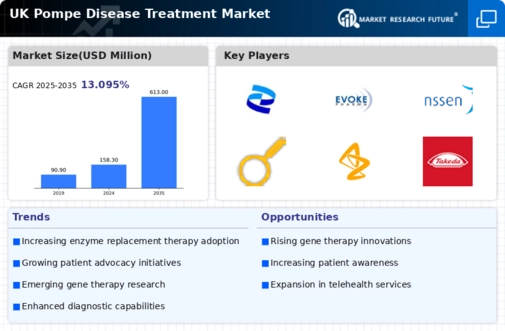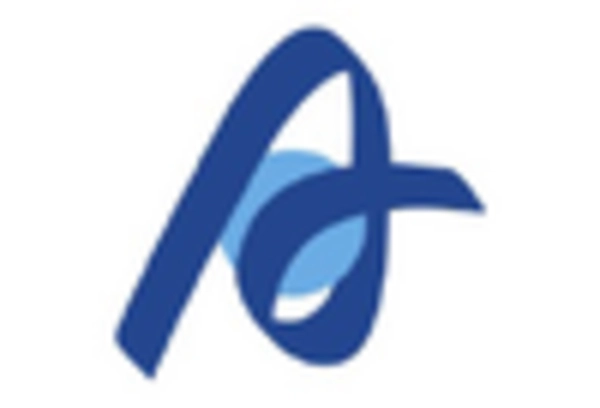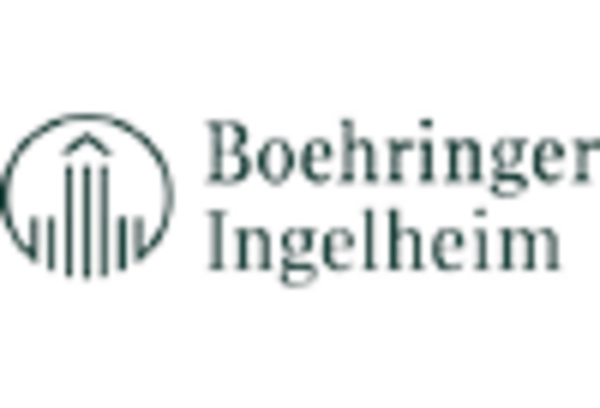Advancements in Gene Therapy
Recent advancements in gene therapy represent a transformative driver for the pompe disease-treatment market. Innovative approaches, such as adeno-associated virus (AAV) vectors, are being explored to provide long-lasting solutions for patients. These therapies aim to correct the underlying genetic defect responsible for Pompe disease, potentially offering a one-time treatment option. The UK has seen a surge in clinical trials focusing on gene therapy, with several promising candidates entering late-stage development. This shift towards gene-based treatments could significantly alter the treatment paradigm, reducing the long-term burden on healthcare systems. As these therapies progress through regulatory pathways, they are likely to attract substantial investment, thereby propelling the growth of the pompe disease-treatment market.
Rising Incidence of Pompe Disease
The increasing incidence of Pompe disease in the UK is a crucial driver for the pompe disease-treatment market. Recent estimates suggest that the prevalence of this rare genetic disorder is approximately 1 in 40,000 live births. This rising incidence necessitates the development and availability of effective treatments, thereby stimulating market growth. As more individuals are diagnosed, the demand for therapies, including enzyme replacement therapy (ERT), is likely to escalate. The growing patient population not only increases the need for treatment options but also encourages research and development efforts within the industry. Consequently, pharmaceutical companies are investing in innovative solutions to address the unmet medical needs of patients suffering from Pompe disease, which is expected to further enhance the market landscape.
Growing Collaboration Between Stakeholders
Collaboration among various stakeholders, including pharmaceutical companies, academic institutions, and patient advocacy groups, is emerging as a significant driver for the pompe disease-treatment market. These partnerships facilitate knowledge sharing, resource pooling, and the acceleration of clinical trials. In the UK, collaborative efforts are being made to enhance patient access to therapies and improve treatment outcomes. For example, joint initiatives between industry and academia are focusing on developing innovative therapies and conducting pivotal research. Such collaborations not only expedite the drug development process but also ensure that patient perspectives are integrated into treatment strategies. This synergy among stakeholders is likely to strengthen the pompe disease-treatment market, fostering a more comprehensive approach to addressing the needs of patients.
Regulatory Incentives for Drug Development
Regulatory incentives play a pivotal role in shaping the pompe disease-treatment market. In the UK, the Medicines and Healthcare products Regulatory Agency (MHRA) has established frameworks to expedite the approval of treatments for rare diseases. These incentives include fast-track designations and market exclusivity, which encourage pharmaceutical companies to invest in the development of therapies for Pompe disease. The promise of a streamlined regulatory process can significantly reduce the time and cost associated with bringing new treatments to market. As a result, more companies may be motivated to explore this niche, leading to a broader array of treatment options for patients. This supportive regulatory environment is likely to enhance the growth trajectory of the pompe disease-treatment market.
Increased Funding for Rare Disease Research
The growing emphasis on rare disease research funding is a notable driver for the pompe disease-treatment market. In the UK, government initiatives and private sector investments are increasingly directed towards understanding and treating rare diseases, including Pompe disease. For instance, the UK Rare Diseases Strategy aims to improve diagnosis, treatment, and care for patients with rare conditions. This strategic focus has led to increased financial support for research and development, fostering innovation in treatment options. As funding becomes more accessible, researchers are likely to explore novel therapeutic avenues, enhancing the overall treatment landscape. This influx of resources is expected to stimulate the pompe disease-treatment market, ultimately benefiting patients and healthcare providers alike.

















Leave a Comment